Ever wondered how to transform your living room into a serene sanctuary that exudes calm and sophistication? Minimalist living room design has skyrocketed in popularity because it masterfully combines simplicity with elegance, creating spaces that feel open, uncluttered, and effortlessly stylish. More than just a trend, minimalism offers a peaceful escape from the chaos of everyday life, making your home a true retreat.
In this article, you’ll find a treasure trove of inspiration and practical ideas to elevate your living space with minimalist charm. From choosing the right color palettes and furniture to clever storage solutions and artistic accents, we cover a wide range of tips to help you craft a sleek, functional, and visually appealing living room. Whether you’re starting fresh or simply looking to refine your current design, these ideas will guide you toward a beautifully minimalist home that promotes relaxation and clarity.
1. Opt for a Neutral Color Palette to Create Calm and Cohesion

Choosing a neutral color palette is the foundation of a serene and cohesive minimalist living room. It helps create a calm atmosphere by reducing visual noise, making the space feel more open and inviting. This approach also allows other design elements, like textures and shapes, to stand out without competing for attention.
Imagine a living room bathed in soft shades of beige, warm gray, and crisp white. The walls are painted in a gentle dove gray, complemented by a plush, cream-colored sectional sofa. Light wood accents, such as a coffee table and sideboards, add warmth while maintaining the understated vibe. Soft textiles like a taupe throw blanket and woven cushions enhance tactile richness, while the overall color scheme fosters a peaceful, cohesive environment that promotes relaxation.
To achieve this look, start by selecting a few core neutral tones and stick to them across your walls, furniture, and accessories. Opt for matte finishes on paint and furniture to avoid glare. Incorporate subtle variations in shades through different textures to add depth without disrupting the calming palette. Keep decorative accents minimal—think ceramic vases or a simple woven basket—to maintain the uncluttered aesthetic. This process is budget-friendly and flexible, allowing you to easily update or layer in new textures over time.
2. Choose Sleek, Low-Profile Furniture for a Modern Look
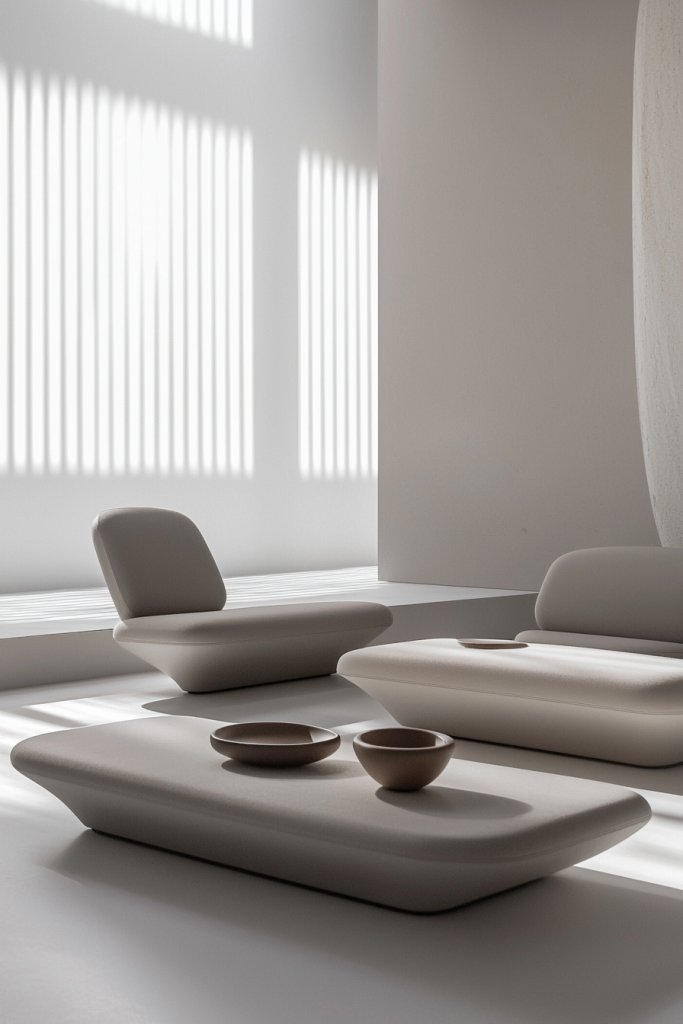
Sleek, low-profile furniture defines the modern minimalist aesthetic by emphasizing clean lines and unobtrusive forms. It makes a room feel more spacious and open, perfect for creating a clutter-free, contemporary vibe. These pieces serve as functional focal points without overwhelming the space, ensuring a balanced and grounded environment.
Picture a low-slung sofa with slim metal legs and a streamlined silhouette, upholstered in a soft, neutral fabric like charcoal gray or beige. A minimalist coffee table with a glass top and slender black metal frame sits nearby, complemented by a slim-profile media console. The furniture’s clean lines and unobtrusive height allow your eyes to move freely around the room, emphasizing openness. The overall effect is a sleek, airy space that feels effortlessly modern and inviting.
To incorporate this idea, look for furniture with simple geometric shapes—think rectangular or oval profiles—and avoid ornate details. Opt for pieces made from quality materials like steel, wood, or acrylic that emphasize simplicity and durability. Keep scale in mind: low-profile furniture should complement the room’s size without overpowering it. For DIY options, consider repurposing or building custom pieces with straight lines and minimal ornamentation. This approach is accessible and adaptable to various budgets, making it easy to achieve a sophisticated, minimalist look.
3. Incorporate Hidden Storage Solutions to Maintain Clean Surfaces

Hidden storage is essential for keeping a minimalist living room tidy and free of visual clutter. It allows you to store everyday items out of sight while maintaining a sleek, organized appearance. This approach supports the principle that less visible clutter creates a more calming and spacious environment.
Visualize a living room with a custom-built media unit seamlessly integrated into the wall, with push-to-open doors that conceal electronics, books, and accessories. Alternatively, use furniture pieces like ottomans with storage inside or coffee tables with hidden compartments. These solutions keep your surfaces clear, showcasing only carefully selected decorative objects or textiles, while the bulk of your belongings are tucked away neatly. The result is a streamlined space that feels orderly and relaxing, with surfaces that invite touch and visual appreciation.
To implement hidden storage, start with multifunctional furniture such as storage ottomans, side tables with drawers, or wall-mounted cabinets. Choose pieces made from durable materials like engineered wood or laminate, which can be customized or purchased ready-made. For a simple DIY project, add baskets or fabric bins inside open shelving units to conceal clutter. Prioritize accessibility and flexibility so the storage solutions adapt easily to your daily routine. This not only keeps your living room looking pristine but also reduces stress and saves time in maintaining the space.
4. Use Geometric Shapes in Decor to Add Visual Interest Without Clutter

Incorporating geometric shapes into decor introduces visual interest and structure while adhering to minimalist principles. These clean, bold forms add a contemporary edge without overwhelming the space, helping to create a balanced, harmonious environment.
Picture a set of ceramic sculptures with angular, abstract forms placed on a sleek sideboard. Geometric-patterned cushions in black and white rest on a neutral sofa, or a modern area rug featuring bold triangles or hexagons anchors the seating arrangement. The use of geometric shapes in lamps, mirrors, or decorative objects adds a layer of visual intrigue that draws the eye but doesn’t clutter the space. The key is to balance these elements carefully, ensuring they serve as focal points rather than distractions.
To achieve this look, select decor items featuring geometric shapes—think polygonal vases, angular lamps, or framed prints with simple lines. Stick to a limited color palette—black, white, or metallics—to keep the look cohesive. Incorporate these shapes sparingly, placing them thoughtfully to guide the eye around the room. DIY enthusiasts can create geometric art or sculptures using materials like painted wood or clay. This approach is cost-effective and allows for personal customization, adding a modern, artistic flair to your minimalist living room.
5. Select Multi-Functional Furniture for Space Efficiency
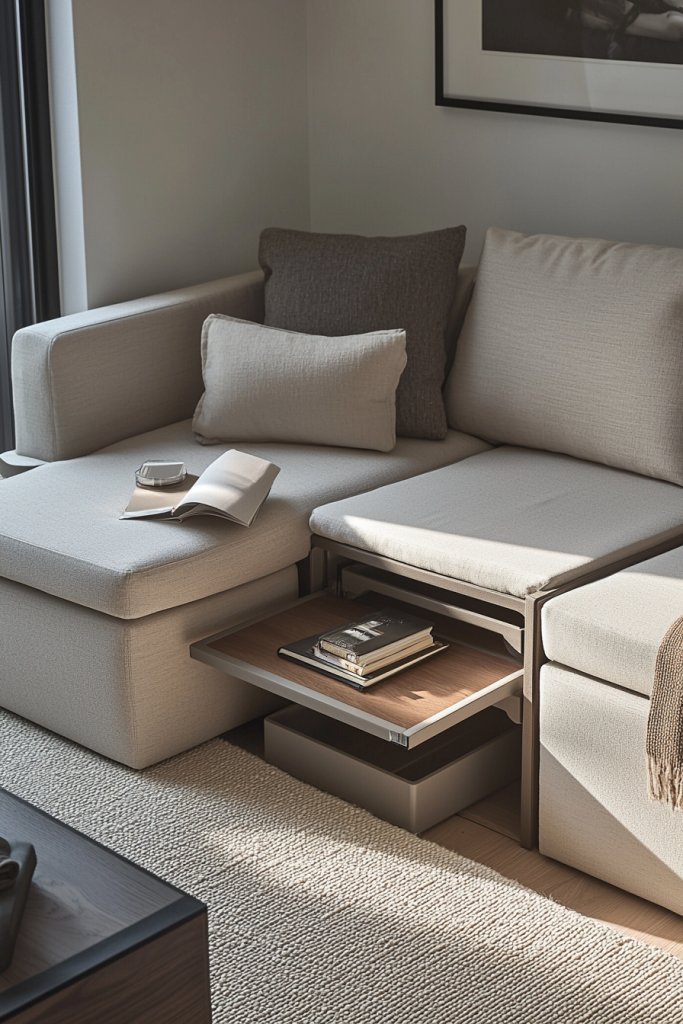
Multi-functional furniture maximizes space and functionality, making it ideal for smaller or open-plan living rooms. It supports the minimalist ethos by reducing the need for multiple pieces, while offering practical solutions tailored to everyday needs.
Imagine a sleek sofa bed with a hidden mattress that transforms from seating to a guest bed in seconds. A coffee table with built-in storage compartments or an extendable dining table that can be tucked away when not in use adds versatility. A modular sectional with adjustable components allows you to reconfigure the space as needed, whether for relaxing, entertaining, or working. These pieces keep the room uncluttered, while providing everything you need in one streamlined setup.
To incorporate multi-functional furniture, start with essentials like a storage ottoman or a fold-out sofa. Look for pieces with integrated storage compartments or extendable features—many affordable options are available online or at furniture stores. For a DIY touch, repurpose existing furniture, such as adding storage baskets underneath a coffee table or building a foldable wall desk. Choosing versatile furniture not only saves space but also simplifies your living environment, making daily routines smoother and more organized.
6. Embrace Negative Space to Highlight Key Design Elements
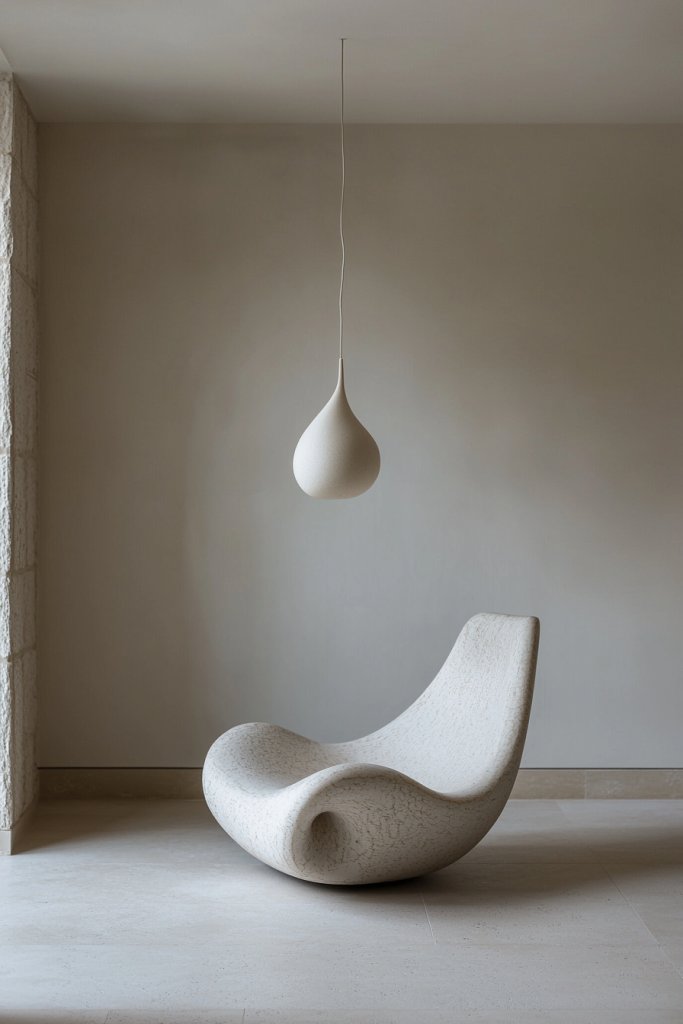
In minimalist living room design, negative space is a powerful tool that allows your key decor features to breathe and stand out. It creates a sense of calm and order, making the space feel open and inviting rather than cluttered or overwhelming.
Visualize a spacious room with a neutral-colored sofa, a few carefully chosen sculptures, and a large, unadorned wall. The empty areas around these elements draw your eye directly to them, emphasizing their shape and texture. Soft natural light filters in through simple, unadorned windows, highlighting the clean lines and uncluttered surfaces. The overall effect is a balanced, serene environment where each piece commands attention without competing for space. The air feels lighter, and the room exudes a sense of tranquility and intentionality.
To incorporate negative space, start by decluttering your living room—remove excess furniture and accessories. Choose a few statement pieces, like a sleek coffee table or a sculptural vase, and give them room to shine by leaving ample empty space around them. Opt for simple, neutral-colored furniture and keep decorative items minimal. Remember, less is more; allowing empty areas within your space will help highlight your carefully selected design elements and create that peaceful minimalist vibe.
7. Incorporate Textured Fabrics in Cushions and Throws for Subtle Warmth
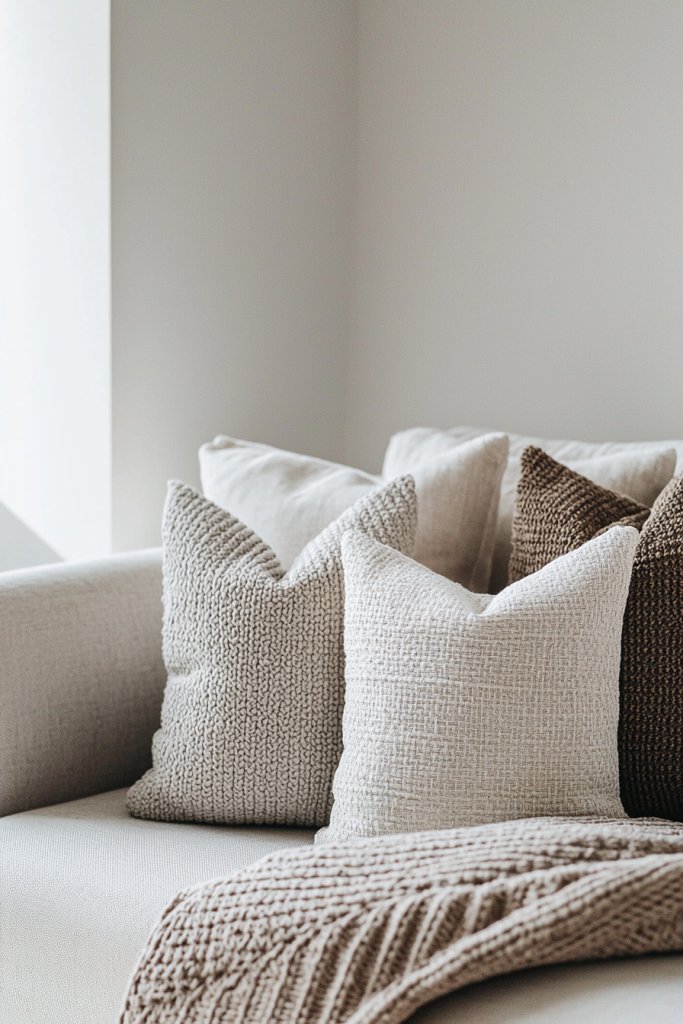
Adding textured fabrics in cushions and throws can bring a cozy, inviting feel to your minimalist living room without sacrificing its clean aesthetic. These tactile elements introduce depth and subtle warmth, balancing the sleek surfaces and sharp lines often associated with minimalist design.
Picture a soft, cream-colored throw blanket with chunky knit texture draped over a streamlined sofa, paired with cushions in different textures—perhaps a smooth linen pillow alongside a velvety one with subtle pleats. The tactile variation invites comfort and adds visual interest, making the space feel layered and thoughtfully curated. Natural fibers like wool, linen, or boucle in neutral tones enhance the calming atmosphere and subtly engage the senses. These textures also soften the overall look, preventing the room from feeling sterile or cold, while maintaining its elegant simplicity.
To achieve this look, choose cushions and throws made from natural, textured fabrics such as wool, linen, or boucle. Mix and match different textures within a similar color palette—think soft beiges, warm greys, or muted earth tones—to create cohesion. Incorporate a chunky knit or ribbed throw on your sofa and pair it with cushions that have subtle patterns or textures. These small details will add warmth and tactile richness, elevating your minimalist space with comfort and subtle sophistication.
8. Use Monochromatic Color Schemes to Enhance a Sense of Serenity
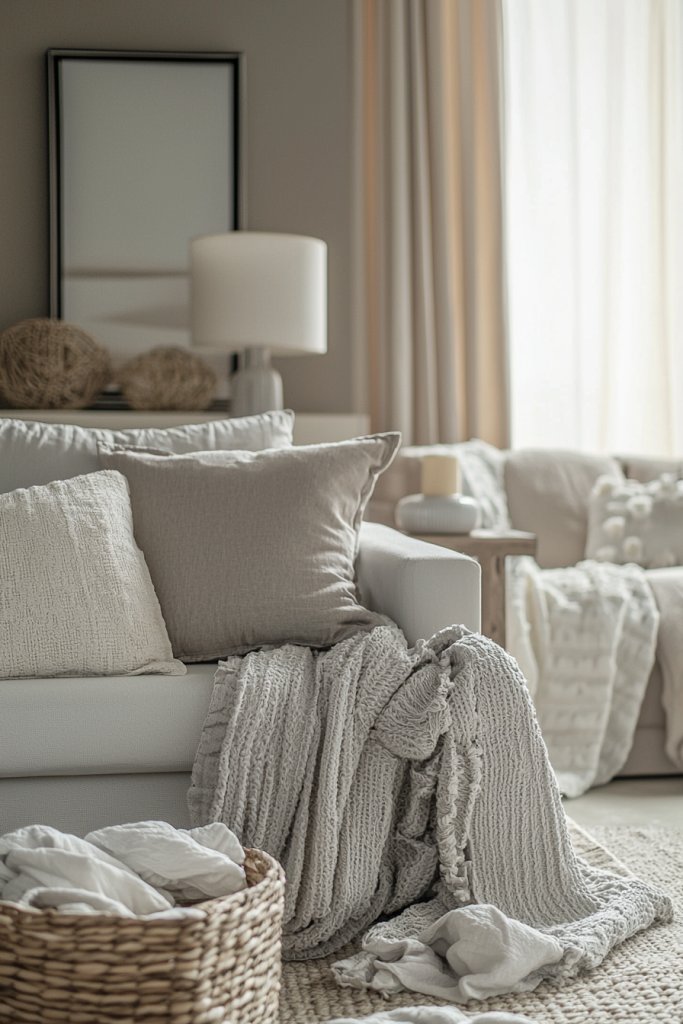
A monochromatic color scheme amplifies the peaceful, cohesive aesthetic of a minimalist living room by sticking to varying shades of a single color. This approach simplifies decision-making and creates a harmonious environment that promotes calm and relaxation.
Imagine a room dominated by soft shades of gray, from light dove to charcoal, with furniture, walls, and textiles all echoing this palette. The different tones add depth and dimension without disrupting the sense of unity. Incorporate textures—like a plush velvet sofa, a woven rug, and matte-finish ceramics—to keep the space visually engaging despite the limited color range. Subtle variations in hue and texture prevent monotony, while the consistent color palette fosters a serene atmosphere that feels balanced and intentional.
Start by selecting a base color you love—such as beige, blush, or deep navy—and build your space around it. Use different shades for walls, furniture, and accessories, ensuring they complement each other. Incorporate textured fabrics, matte finishes, and smooth ceramics in similar tones to add variety. This monochromatic strategy simplifies decorating choices and results in a calming, cohesive living room that feels both modern and timeless.
9. Add Statement Lighting Fixtures for Functional Elegance
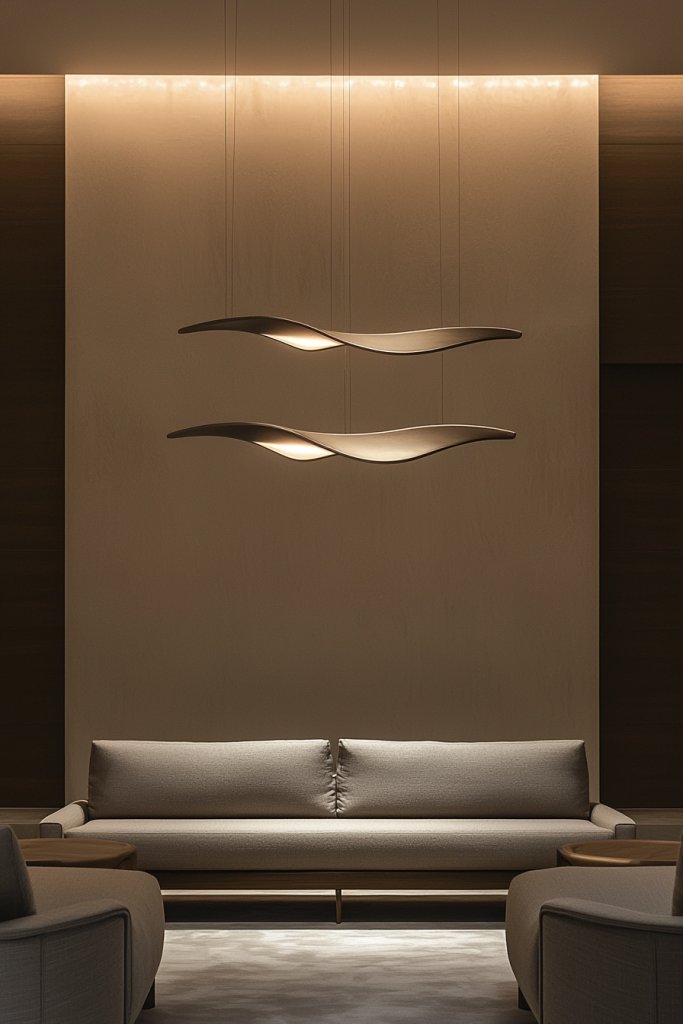
In minimalist living rooms, a striking lighting fixture can serve as a functional centerpiece that elevates the entire space with its sleek, sculptural presence. It combines practicality with aesthetic appeal, adding a touch of elegance while providing essential illumination.
Picture a large, geometric pendant light hanging above the seating area, crafted from matte black metal or frosted glass. Its bold shape and clean lines draw the eye and create a focal point, contrasting beautifully with neutral walls and simple furniture. Soft, warm light emanates from it, casting gentle shadows that enhance the room’s textures and architectural details, creating an inviting ambiance. Well-chosen lighting not only brightens the space efficiently but also adds an element of sophistication and visual interest.
To incorporate statement lighting, select fixtures with minimalist design—think sleek metal pendants, modern chandeliers, or sculptural floor lamps. Position these fixtures strategically: a pendant over the coffee table or a tall, sculptural lamp beside the sofa. Keep the design simple, with finishes like matte black, brushed brass, or matte white, to complement your overall aesthetic. These lighting pieces will serve as functional art, adding both practicality and a touch of refined style to your minimalist living room.
10. Keep Decor Minimal with a Few Carefully Chosen Art Pieces

In a minimalist living room, less truly is more—especially when it comes to decor. Choosing a few meaningful, carefully curated art pieces can create focal points that enhance the space without overwhelming it, fostering a sense of calm and sophistication.
Imagine a large, single piece of abstract art in muted tones hung above the sofa, or a sleek black-and-white photograph framed simply on an empty wall. These select art pieces serve as visual anchors, drawing attention and adding personality without cluttering the room. The key is to choose artwork that resonates emotionally or complements your color palette and overall design. Keep framing minimal—think thin black or metal borders—to maintain the clean aesthetic, and allow ample space around each piece to emphasize its importance.
Start by selecting one or two impactful artworks—whether a statement canvas or a striking photograph—and hang them at eye level. Avoid overcrowding walls with multiple small pieces; instead, focus on quality over quantity. Use simple frames and neutral backgrounds to keep the look cohesive. This approach highlights your art choices as intentional design elements, elevating your living room’s style while maintaining the minimalist principle of “less is more.”
11. Use Open Shelving to Display Select Decorative Objects
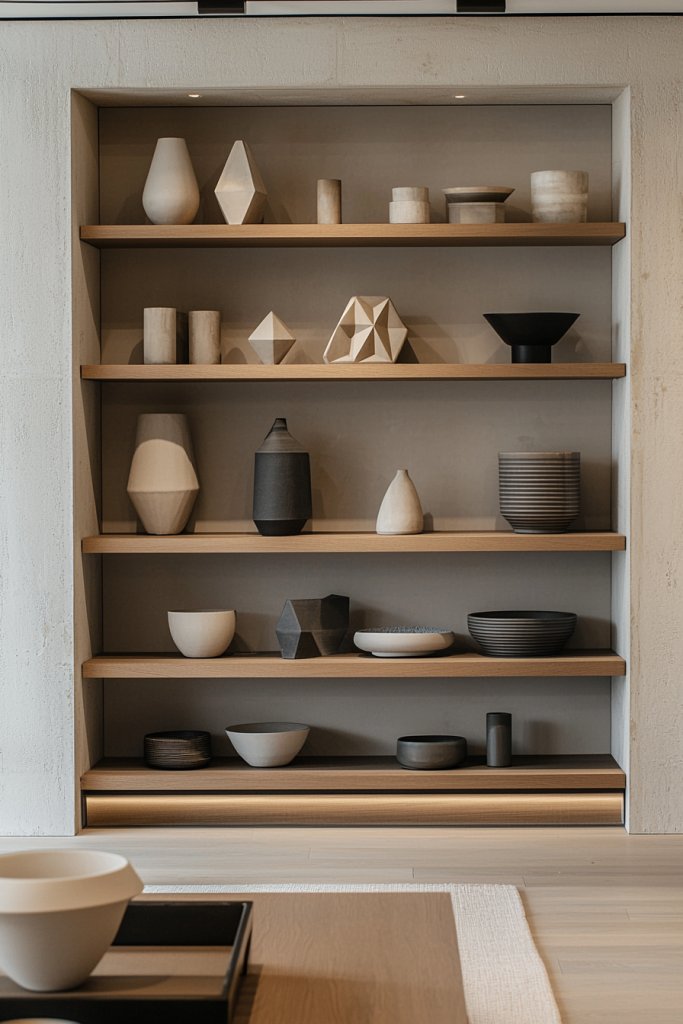
Open shelving is a fantastic way to add personality and visual interest to a minimalist living room without cluttering the space. It allows you to showcase a curated collection of decorative objects, keeping the overall look clean yet personalized. When done thoughtfully, open shelves can serve as focal points that highlight your style while maintaining an airy feel.
Imagine sleek, floating wooden shelves mounted against a crisp white wall, holding a few carefully chosen items like textured ceramic vases, minimalist sculptures, or monochrome books stacked artfully. The items are spaced out generously, allowing each piece to breathe and stand out. The textures—matte ceramics, smooth glass, or woven baskets—add subtle depth, while the neutral or muted color palette keeps the space calm. The open shelving not only displays your favorite decor but also makes the room feel more open and accessible, inviting the eye to explore without feeling overwhelmed.
To implement this concept, start by selecting a sturdy, simple shelving system—preferably in natural wood or painted in a neutral tone. Mount the shelves at varying heights for visual interest, but keep the overall arrangement balanced. Choose 3-5 decorative objects per shelf, focusing on quality over quantity; think small sculptures, ceramic bowls, or a few artfully arranged books. Keep clutter to a minimum and regularly rotate pieces to keep the display fresh. Simple tools like a drill, level, and measuring tape will help you achieve a professional look with minimal effort.
12. Incorporate Natural Materials like Wood and Stone for Warmth

Using natural materials such as wood and stone introduces warmth and texture into a minimalist living room, making the space feel inviting rather than cold or sterile. These elements ground the design, offering a tactile quality that enhances the overall aesthetic while maintaining clean, simple lines.
Picture a light oak coffee table with smooth, rounded edges paired with a slate-gray stone fireplace surround. The warm wood’s soft grain contrasts beautifully with the cool, matte surface of the stone, creating a balanced harmony. Incorporate textiles like a woven jute rug or linen cushions to complement these materials. The scent of natural wood and stone can subtly fill the room, adding sensory richness, while the varied textures prevent the space from feeling too monotonous. Overall, these materials lend a timeless, organic feel that elevates minimalist design with subtle sophistication.
To incorporate natural materials effortlessly, choose furniture pieces made from reclaimed or sustainably sourced wood—such as a low-profile sideboard or open shelving unit. Add decorative accents like a stone vase or a clay sculpture for visual interest. For flooring, opt for a jute or sisal rug that complements the warm tones of wood. When sourcing, look for local artisans or eco-friendly brands that prioritize sustainability. Keep the overall look simple, with minimal ornamentation, so the beauty of these natural elements remains the star of your living room.
13. Prioritize Clean Lines in All Furniture and Accessories
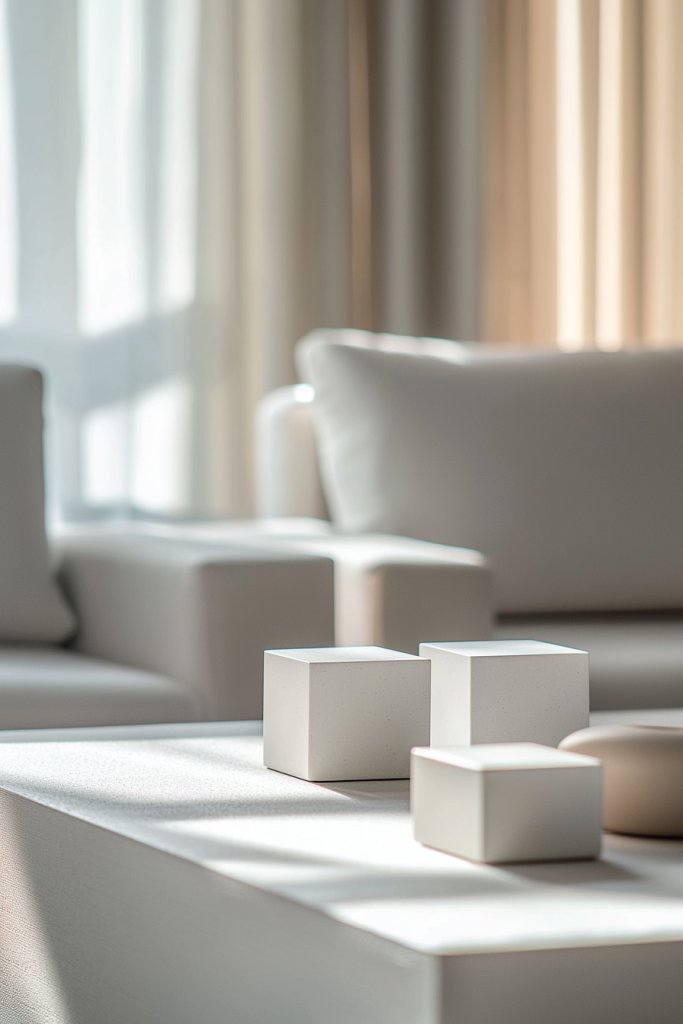
Clean lines are the cornerstone of minimalist design, creating a sleek, uncluttered look that emphasizes form and function. Prioritizing these lines ensures that every piece in your living room contributes to a cohesive, modern aesthetic that feels open and orderly.
Visualize a sofa with a slim, streamlined silhouette, featuring a low back and slender metal legs, paired with a rectangular coffee table with sharp, simple edges. Accessories like a geometric floor lamp or a rectangular side table enhance the sense of order, with their straight, unembellished shapes. The overall effect is a space that feels crisp and uncluttered, where each element has a purpose and contributes to the visual flow. The absence of ornate details allows the clean lines to dominate, creating a calming environment that promotes relaxation and focus.
To achieve this, select furniture with simple, unadorned frames—think rectangular or square shapes in neutral tones. Avoid overly ornate or bulky pieces that can disrupt the visual harmony. When accessorizing, choose items with straight or gently curved lines in a monochrome palette, like a minimalist ceramic vase or a sleek metal clock. Always measure carefully to ensure proportions are balanced, and keep surfaces clear of unnecessary clutter. This approach guarantees a harmonious, streamlined space that embodies minimalist elegance.
14. Use Large-Scale Rugs to Anchor the Space and Add Pattern
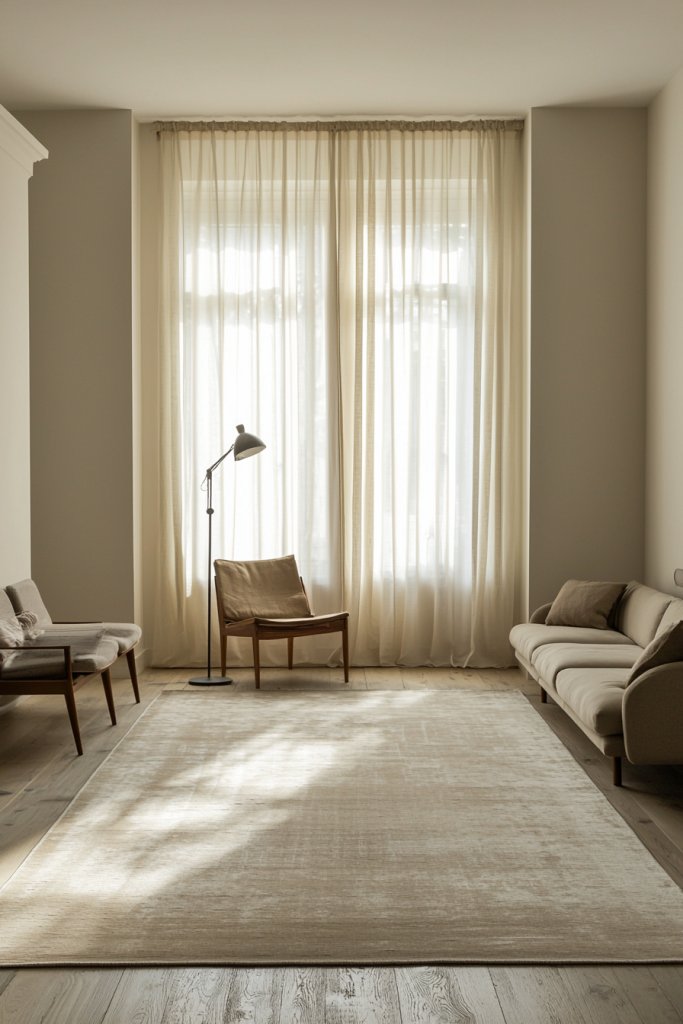
A large-scale rug serves as the foundation of your minimalist living room, defining the seating area and adding visual weight without overwhelming the clean aesthetic. It creates a sense of cohesion and comfort, anchoring furniture while subtly introducing patterns or textures.
Envision a plush, neutral-toned rug in soft beige or stone gray, covering a significant portion of the floor and stretching beneath a low-profile sofa and coffee table. Its size ensures that all furniture pieces sit comfortably on it, creating a unified zone. The texture of the rug—perhaps a subtle geometric weave or a smooth loop pile—adds depth and tactile interest, making the space feel warm and inviting. The large scale of the rug ensures that the pattern or texture becomes a focal point, balancing the minimalist elements with a touch of visual intrigue.
To incorporate a large rug effortlessly, measure your space accurately and choose a design that complements your color palette—solid neutrals or subtle patterns work best. Opt for high-quality, durable materials like wool or synthetic fibers designed for easy cleaning. Place your furniture on the rug with at least a few inches of border showing to create a cohesive look. If budget is a concern, consider oversized, affordable options from home goods stores or online retailers, and add a textured throw or cushions to enhance the overall aesthetic.
15. Incorporate Mirror Accents to Enhance Light and Perception of Space

Mirrors are a clever and stylish way to amplify natural light and create the illusion of a larger, more open living room. They reflect both daylight and interior elements, enhancing the minimalist aesthetic with a sense of depth and brightness.
Imagine a large, frameless mirror leaning against a wall or a sleek, geometric wall-mounted mirror with clean edges. Its reflective surface catches sunlight streaming through your windows, bouncing it around the room and making the space feel airy and expansive. The mirror’s simple design keeps the look minimalist—no ornate frames or distracting embellishments—while its reflective quality visually doubles the space. Place the mirror opposite a window or next to a light source to maximize its effect, and consider pairing it with neutral-colored furniture and decor for a cohesive, calm environment.
To incorporate a mirror, start with a size that complements your wall space—large enough to make an impact but proportionate to your room. Choose frameless or slim-framed options in metal or matte finishes for a modern touch. Secure the mirror properly using appropriate wall anchors or stands, depending on placement. Regularly clean the surface to keep reflections clear, and use strategically to brighten dark corners or to create focal points that enhance your living room’s minimalist vibe.
16. Limit Accessories to Essential Items for a Clutter-Free Environment

Creating a minimalist living room is all about prioritizing quality over quantity, especially when it comes to accessories. By limiting decorative items to only those that serve a purpose or truly bring joy, the space feels calm and intentional rather than cluttered. This approach helps maintain a serene atmosphere where every piece has a reason to be there.
Visualize a living room with a sleek, neutral-toned sofa accented by a single textured throw blanket and a few carefully selected cushions. A minimalist coffee table might hold just a simple ceramic vase with fresh flowers or a modern sculpture, while the walls remain free of excess art or photos. The result is a space that feels open and balanced, with each item contributing to the overall harmony. The sensory experience is one of calm, with a visual focus on clean lines and subtle textures that invite relaxation.
To achieve this, start by editing your current accessories—remove anything that doesn’t serve a clear purpose or add meaningful beauty. Choose a few statement pieces, like a sculptural bowl or a sleek candle holder, and place them intentionally. Keep surfaces clear by storing excess items out of sight, perhaps in hidden storage or drawers. Focus on selecting high-quality, understated pieces that complement your color palette and reflect your personal style, ensuring your living room remains clutter-free and effortlessly chic.
17. Use Built-In Storage to Maximize Floor Space
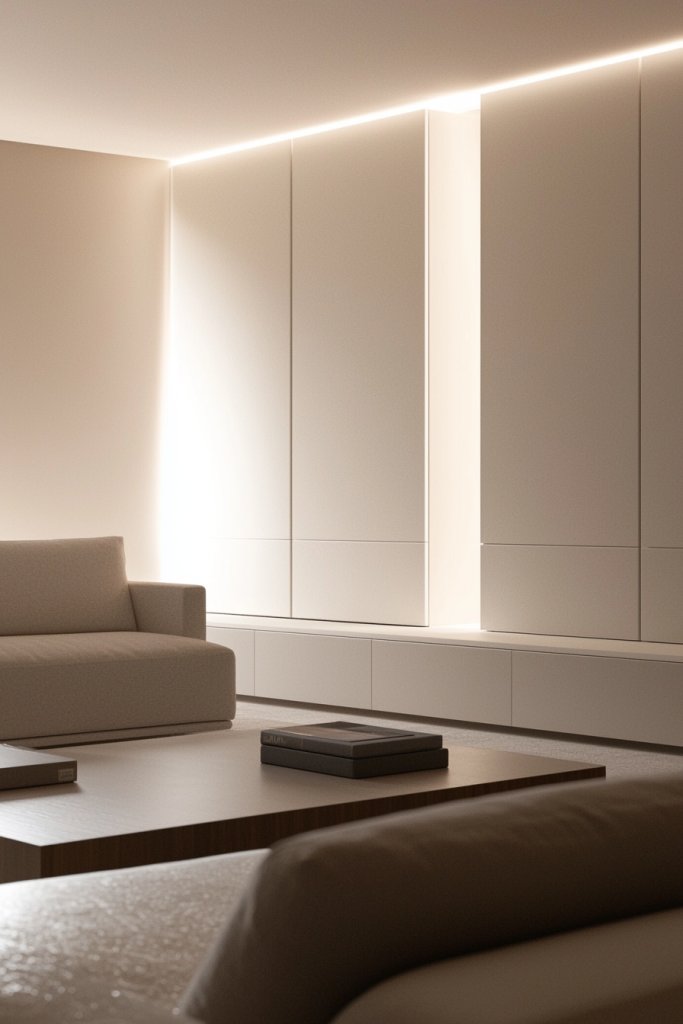
Built-in storage solutions are a game-changer in minimalist living rooms, offering a sleek way to hide clutter and create a seamless, open environment. By integrating storage directly into walls or furniture, you free up valuable floor space, making the room feel larger, more airy, and more organized.
Imagine a wall-mounted media unit with hidden compartments, or custom cabinetry that blends seamlessly with your wall color. These solutions often feature clean lines and simple hardware, such as push-to-open mechanisms or handleless designs, enhancing the minimalist aesthetic. This approach not only keeps everyday essentials out of sight but also adds a polished, custom look that elevates the entire room. The space feels calm and uncluttered, with a subtle sense of order that’s easy to maintain.
To implement, start by assessing your storage needs and measuring available wall space. Consider options like built-in shelves with enclosed cabinets or recessed niches for electronics and accessories. You can work with a carpenter or DIY with modular units, using materials like MDF or plywood finished in neutral tones. Incorporate soft-close doors or drawers to maintain sleekness. By choosing integrated storage, your living room stays open and inviting, with everything neatly tucked away yet easily accessible.
18. Select Simple, Unadorned Window Treatments for a Streamlined Look
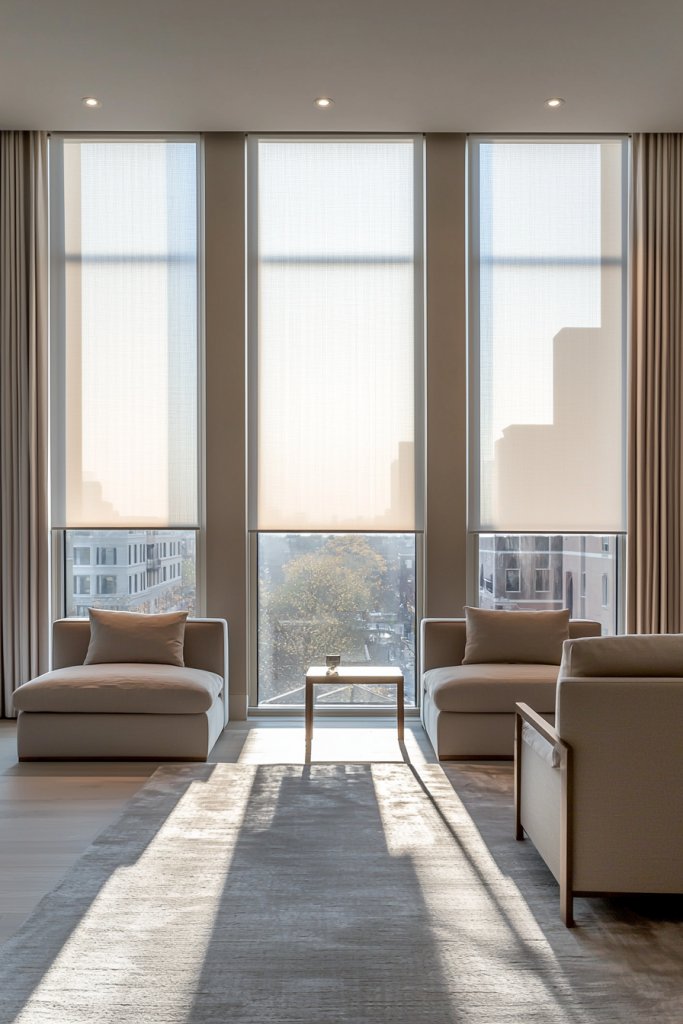
Window treatments are a subtle yet impactful element in minimalist living rooms, and choosing simple, unadorned options helps maintain clean lines and a clutter-free aesthetic. By avoiding heavy drapes or ornate valances, you allow natural light to flood the space and keep the overall look sleek and cohesive.
Picture sheer white roller blinds or plain linen curtains in a soft, neutral hue hanging close to the window frame. These fabrics gently diffuse sunlight, creating a warm, inviting glow that enhances the room’s calm atmosphere. The absence of elaborate patterns or embellishments ensures the focus remains on the room’s architecture and textures, like a cozy sofa or textured cushions. The sensory experience is one of openness and serenity, with minimal visual distraction.
To achieve this look, select window treatments made of light, natural fabrics such as linen, cotton, or voile. Opt for simple designs—roller blinds, flat-panel shades, or unadorned curtains—that can be hung close to the wall for a streamlined appearance. Keep hardware minimal—think sleek rods or concealed tracks—and choose neutral colors that blend seamlessly with your walls. This approach keeps your living room feeling spacious, modern, and effortlessly refined.
19. Integrate Minimalist Art with Bold, Single-Color Pieces
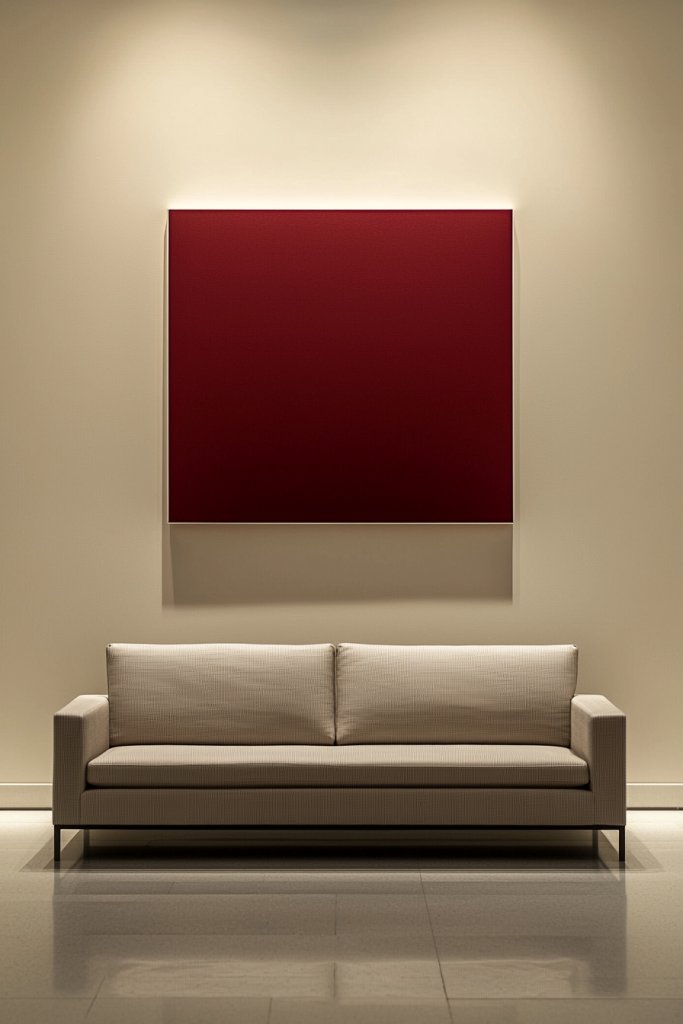
In a minimalist living room, art is a powerful tool to add personality without creating visual chaos. Opting for bold, single-color pieces or simple geometric designs allows you to introduce color and interest while preserving the clean aesthetic. This balance fosters a space that feels curated and thoughtfully styled.
Visualize a large, monochrome canvas in a striking hue—perhaps deep navy or vivid ochre—mounted against a neutral wall, serving as a focal point. The artwork’s bold color pops against the subdued backdrop, creating a sense of depth and visual intrigue. Alternatively, minimalistic geometric prints in black and white or metallic accents add a contemporary touch. The key is choosing pieces that are uncluttered, with clean lines and minimal framing, so they enhance rather than overwhelm the space.
To incorporate this idea, select artwork that resonates with your style—large canvases, framed prints, or even minimalist sculptures. Focus on single-color or simple monochrome palettes to maintain harmony. Hang pieces at eye level, ensuring they complement your furniture and overall color scheme. You can find affordable minimalist art online or create your own with DIY painting. This approach injects personality into your living room with visual impact that aligns perfectly with the minimalist ethos.
20. Choose Sculptural Decor Elements for Artistic Focal Points
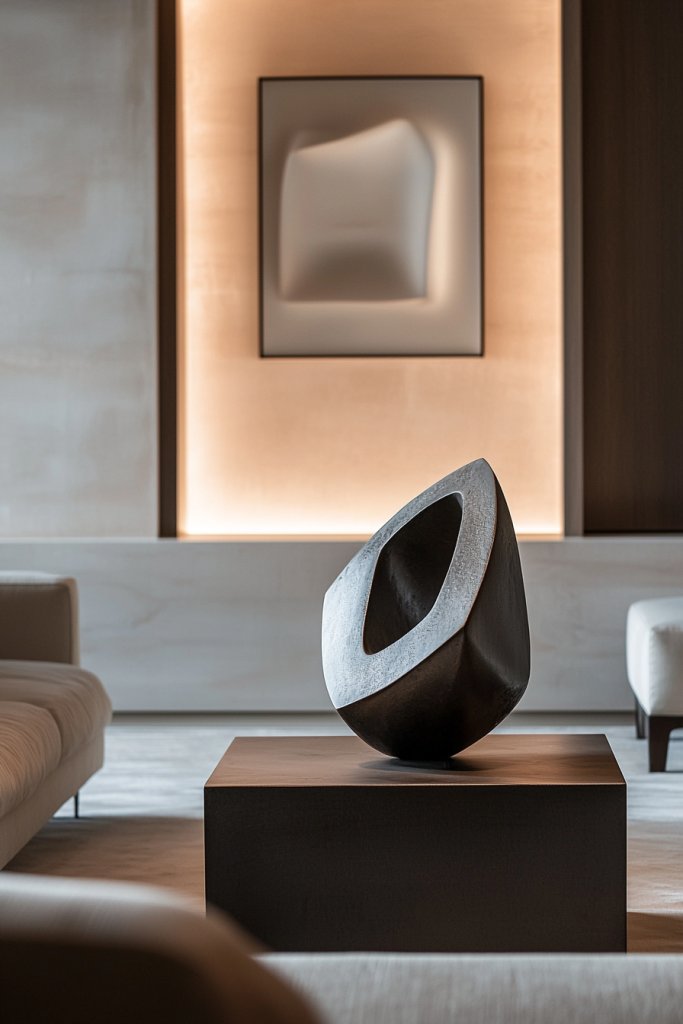
Sculptural decor elements serve as striking focal points that elevate a minimalist living room, adding an artistic touch without cluttering the space. By selecting statement pieces like abstract sculptures, ceramics, or unique decorative objects, you create visual interest that acts as a centerpiece for your design.
Imagine a sleek, modern sculpture made of matte black metal placed on a simple pedestal or a textured ceramic vase with organic shapes positioned on a coffee table. These objects draw the eye and add depth to the room’s decor, offering a sense of artistry and craftsmanship. Their minimalist forms and clean lines ensure they complement rather than compete with the overall aesthetic, acting as subtle yet powerful design accents. The tactile and visual qualities of these pieces enhance the room’s sophistication and personality.
To incorporate sculptural decor, choose pieces made from materials like concrete, wood, or metal that align with your color palette and style. Keep the number of focal objects limited—one or two—so they stand out and don’t overwhelm the space. Place them in prominent locations, such as on a side table, shelf, or console, where they can be appreciated up close. This strategy adds an artistic dimension to your living room, making it both stylish and thoughtfully curated.
21. Incorporate Modular Furniture for Flexible Living Spaces
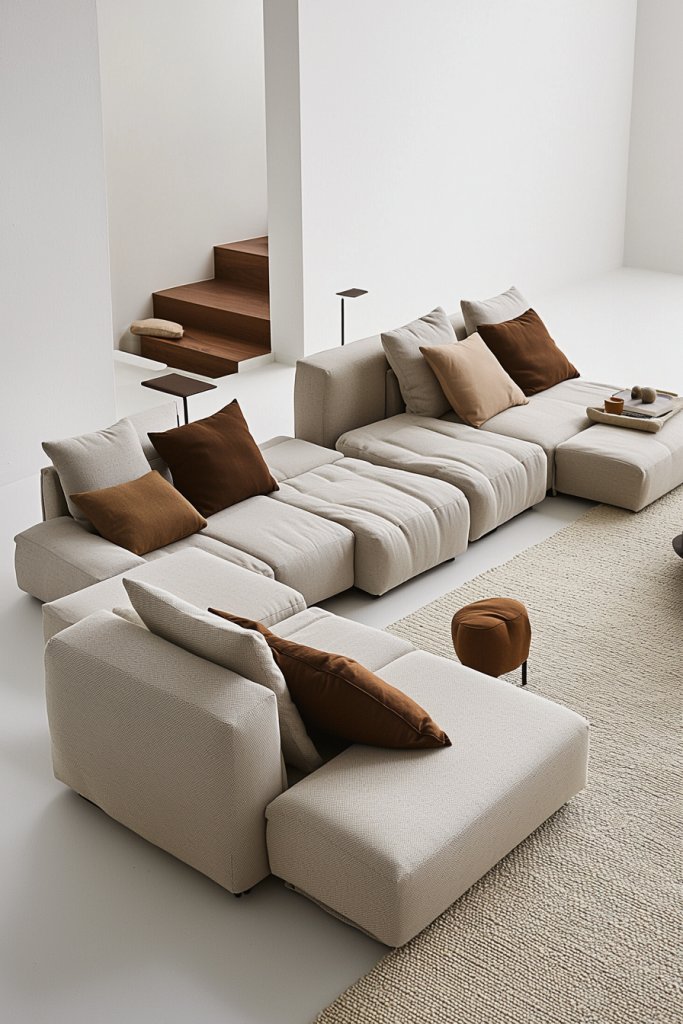
Incorporating modular furniture into your living room design offers unmatched versatility, making your space adaptable to changing needs and lifestyles. This approach allows you to customize your environment easily, creating a sleek, minimalist aesthetic that still offers functional flexibility.
Picture a set of sleek, low-profile modules—like a sectional sofa with removable sections or stackable ottomans—that can be rearranged effortlessly. In a neutral palette of soft grays, warm beiges, or crisp whites, these pieces have clean lines and smooth surfaces, often made from materials like light wood, metal, or upholstered fabrics with subtle textures. When arranged together, they create a cohesive look that feels open and uncluttered, yet can be reconfigured for movie nights, gatherings, or cozy nights alone. The space remains calm, with open pathways and a sense of flow, emphasizing simplicity and adaptability.
To bring this idea to life, start by selecting a modular sofa system or individual pieces like stackable chairs and ottomans. Look for pieces with simple, geometric shapes and neutral tones—think matte finishes and understated hardware. Arrange the modules in different configurations depending on your needs, and keep extra pieces stored neatly away when not in use. No special tools are required—most modular furniture is designed for easy assembly—making it a perfect DIY project for creating a flexible, minimalist living room that evolves with you.
22. Use Clear or Acrylic Furniture to Add Lightness and Openness
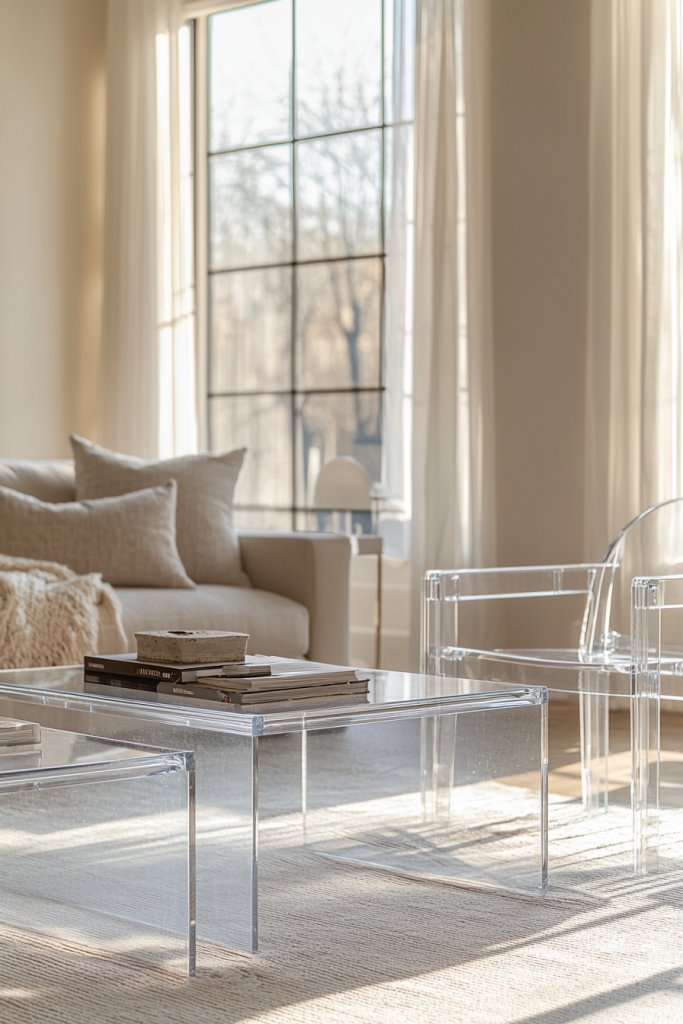
Using clear or acrylic furniture is a game-changer for minimalist living rooms because it visually declutters the space and creates a sense of openness. These transparent pieces blend seamlessly into the environment, allowing light to flow freely and making even small rooms feel larger and more airy.
Imagine a transparent acrylic coffee table with sleek, rounded edges sitting on a soft, monochromatic rug. The surfaces reflect the surrounding light, giving the room a luminous quality, while the subtle presence of the furniture keeps the space feeling uncluttered. Clear acrylic side chairs or a minimalist console table add functional elegance without overwhelming the room’s simplicity. The textures of the surrounding textiles—like a cozy wool throw or a plush cushion—contrast beautifully with the sleek, glossy surfaces, creating a balanced sensory experience.
To achieve this look, choose high-quality acrylic or polycarbonate furniture from trusted brands or online sources. Start with a statement piece like a coffee table or a set of side chairs, and pair with neutral-colored textiles. Assembly is straightforward—most acrylic pieces are lightweight and easy to set up—making it accessible for DIY enthusiasts. Keep other decor minimal, and let the transparency of your furniture enhance the feeling of space, light, and modern elegance.
23. Highlight Architectural Details with Minimalist Design Enhancements
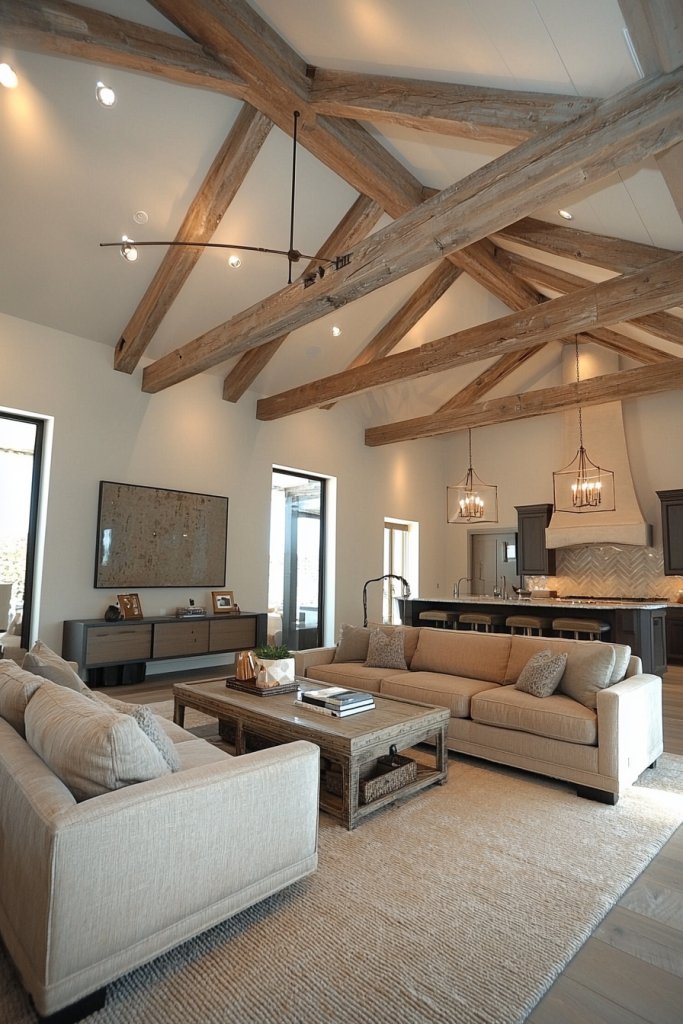
Showcasing architectural details in a minimalist living room elevates the overall aesthetic by emphasizing the room’s natural structure and craftsmanship. Thoughtful, subtle enhancements draw attention to these features without adding visual clutter, creating a harmonious balance between form and function.
Picture a room with clean, smooth wall surfaces, where a simple, unobtrusive crown molding or a floating wall shelf frames a stunning fireplace or a large window. Use neutral tones for walls—soft whites, warm taupes, or cool greys—so that architectural features stand out. Incorporate minimal lighting, like recessed LED strips or hidden spotlights, to highlight these details softly, creating a warm glow that accentuates the room’s natural lines. The overall effect is an uncluttered space that celebrates its structure, inviting calm and appreciation for craftsmanship.
To implement this, start by identifying key architectural features—like a beam, niche, or alcove—and consider how to accentuate them. Use paint or finish treatments that emphasize textures or shapes, such as matte or satin finishes. Install discreet lighting fixtures, like LED strips or small spotlights, to subtly highlight these elements. Keep surrounding surfaces simple and free of unnecessary decor, allowing the architectural details to become the focal points. This approach transforms your living room into a sophisticated space that’s both functional and architecturally expressive.
24. Implement Consistent Hardware and Finishes for a Cohesive Look
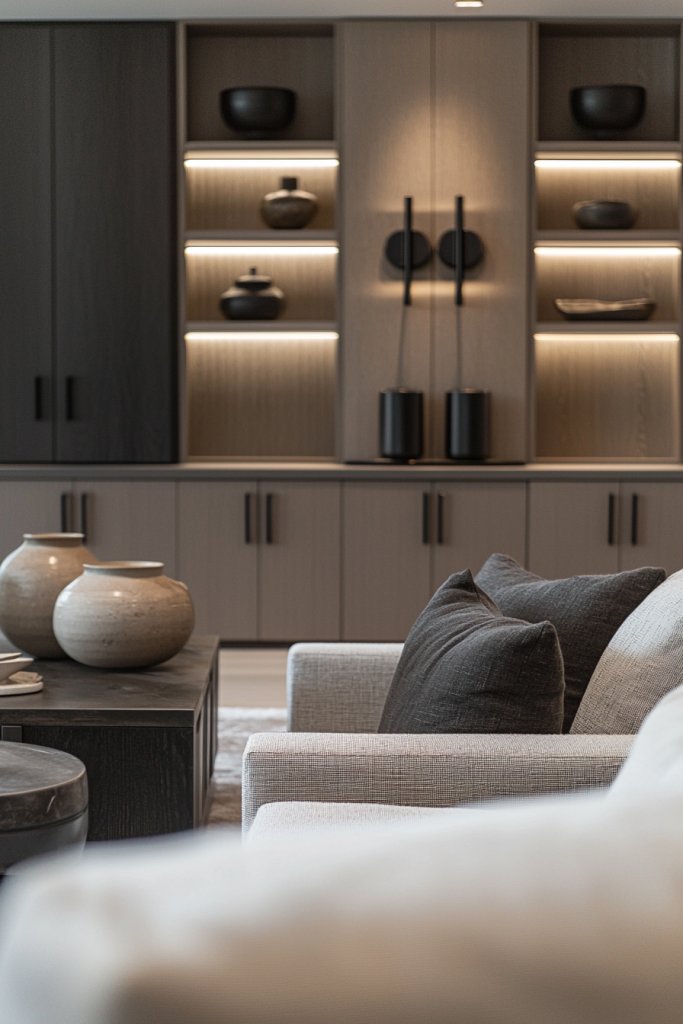
Achieving a cohesive minimalist living room relies heavily on consistent hardware and finish choices across furniture and accessories. Uniformity in these small details creates a polished, harmonious aesthetic that feels intentional and refined.
Envision cabinet handles, drawer pulls, light switch covers, and furniture legs all finished in matching matte black, brushed gold, or sleek chrome. These subtle touches unify disparate elements, preventing visual chaos and enhancing the room’s minimalist vibe. For example, selecting hardware with simple, geometric shapes and a uniform finish—like all matte black—can instantly elevate the design. The consistent hardware also simplifies decision-making during setup and creates a seamless, uncluttered appearance.
To achieve this, start by choosing a signature finish—such as black matte, brushed nickel, or polished brass—and stick with it for all hardware and metal accents. Measure carefully to ensure compatibility, and consider sourcing hardware from the same supplier or collection to guarantee uniformity. Regularly check for signs of wear, and clean hardware with appropriate products to maintain its sleek look. This attention to detail ensures your living room exudes a cohesive, minimalist elegance that feels both modern and thoughtfully curated.
25. Keep the Overall Design Uncluttered and Functional to Promote Relaxation

A truly minimalist living room champions simplicity and functionality, creating an environment that fosters relaxation and mental clarity. Removing unnecessary items and emphasizing purpose-driven design leads to a calm, inviting space.
Visualize a room with only essential furniture—like a low-profile sofa, a simple coffee table, and a comfortable armchair—surrounded by ample negative space. Textiles are kept in neutral tones, with soft textures like a plush throw or a smooth wool rug adding warmth without visual noise. Storage solutions are cleverly integrated, hiding away any items that don’t serve a clear purpose. The atmosphere is quiet, with minimal decor and clutter, allowing your mind to breathe and unwind.
To maintain this state, regularly declutter by removing items that don’t serve a daily function or bring joy. Opt for multifunctional furniture with hidden storage, like an ottoman that doubles as a coffee table or a sofa with built-in compartments. Keep surfaces clear and prioritize quality over quantity in decor choices—think a single sculptural object or a sleek vase. By focusing on essential elements and avoiding excess, you craft a living room that not only looks minimalist but also feels genuinely peaceful and restorative.
Conclusion
With these diverse minimalist living room ideas, you have everything you need to create a space that exudes calm, elegance, and functionality. From choosing a neutral palette and sleek furniture to incorporating natural materials and clever storage solutions, each tip is designed to elevate simplicity without sacrificing style. Embrace these concepts and transform your living area into a serene retreat that reflects your refined taste. Start small, stay intentional, and let your space speak for itself—beautiful simplicity is within your reach.
Leave a Reply